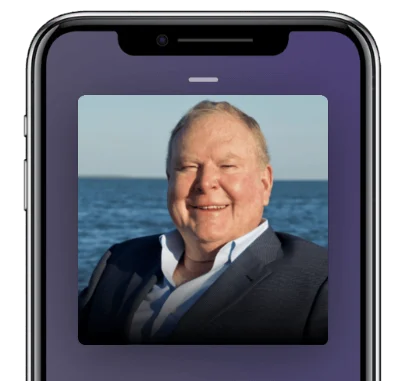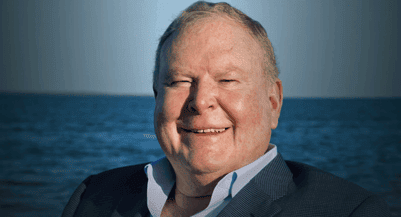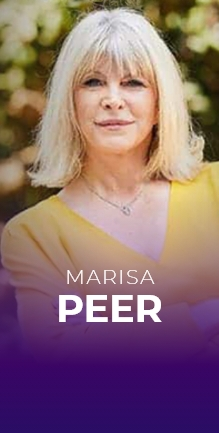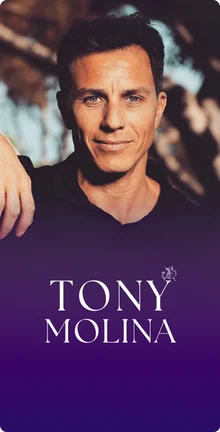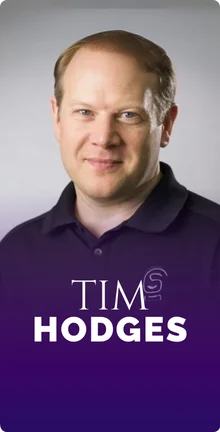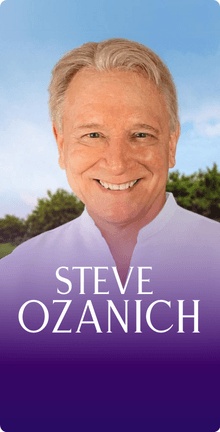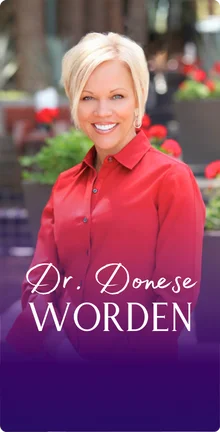In this Episode
- [01:54]What exactly is the Egoscue Method, and why would someone need to use it?
- [03:32]Pete points out that you don’t need to go to an Egoscue clinic in person; they do Skype appointments as well.
- [04:50]In response to Stephan’s description of the “air bench” exercise, Pete explains that exercises aren’t necessarily for the muscles in which you feel them. He also mentions how he came up with many of the exercises.
- [06:23]What does the Egoscue Method provide that the Alexander Method, for example, doesn’t?
- [07:08]Pete describes how his own experiences led to his creation of the Egoscue Method. This led to his nerve pain completely going away, he says.
- [08:44]Most of the Egoscue Method’s public speaking is now done by Bryan Bradley. Stephan then expands on how he became familiar with the method.
- [10:07]We learn how Pete’s connection with Tony Robbins came about, and how Tony became a fan of the Egoscue Method. Pete also talks about Tony’s Life & Wealth Mastery program.
- [13:20]Stephan’s latest book is on personal transformation, rather than his usual topic of internet marketing. He and Pete then talk more about personal transformation.
- [14:40]Pete talks about the way we address pain by looking for the problem then offering the patient a solution. What’s left out, he explains, is the “why” and solving the root of the problem.
- [17:35]Stephan brings up a pain of his own, in his left index finger. Pete then walks him through several steps to reduce this pain.
- [21:35]Now that Stephan’s finger pain is lessened through moving his shoulders and spine, Pete reiterates that the origin of pain isn’t necessarily where you feel the pain itself.
- [23:18]How many different exercises are there in Pete’s database? Over 400, he reveals, then talks about his new machine and how it helps in creating customized menus of exercises.
- [26:16]If you have an Egoscue Method appointment, be honest about how much time you’re willing to devote to these exercises, Pete advises.
- [27:27]Stephan asks Pete’s advice on sitting. Instead of answering briefly, Pete takes us on a journey through the way cells and the body operate.
- [30:47]If you’re sitting in the posture that Pete put Stephan in to help his finger, then sitting itself won’t be a problem, Pete says. He then emphasizes the importance of staying hydrated and explains that chronically dehydrated people have lost their thirst response.
- [33:45]Stephan returns to a point that Pete had mentioned, about varying eyesight being a symptom of dehydration. Pete then elaborates on what he means and how this is related to dehydration.
- [35:13]Pete offers a formula for how much water to drink daily: divide your body weight in half and then convert that to ounces. For example, if you weigh 150 pounds, drink 75 ounces of water a day.
- [36:11]Sugar is poison, Pete explains. He walks us through how the body reacts to sugar, and why that’s a problem. He then advises against consuming certain ingredients, saying that “if you can’t pronounce [the ingredients], neither can your body, and you don’t want to ingest them.”
- [39:24]Pete explains the origin of Gatorade, and the ways in which it’s now different than it was. He and Stephan then talk more about sugar.
- [41:36]Does Pete get his food from local farmers markets?
- [42:14]Pete offers his recommendations for those of us who don’t have private chefs. “You can’t unconsciously eat,” he explains. He then reveals why fast food is bad for you, despite using high-quality ingredients: the intention involved in creating the food.
- [44:59]Pete shares his thoughts on vegetarianism and the Mediterranean diet.
- [46:24]Stephan has recently started blessing his food before he eats it. He mentions what inspired him to make this change, which involves Dr. Emoto’s work with water crystals.
- [48:11]We learn about Pete’s exercise regimen. He spends about half an hour each day on his Egoscue Method menu, and another 60 to 90 minutes on working out.
- [48:49]The body doesn’t know how old it is, Pete reveals, and each of us knows our own health better than anybody on the planet.
- [50:49]Pete asks Stephan if he ever goes to the gym. He then points out the association many people have between effort, results, judgment, and fitness. He then offers his own inspirational definition of fitness.
- [52:26]If someone is interested in learning more about the Egoscue Method or giving it a try, they should go to egoscue.com.
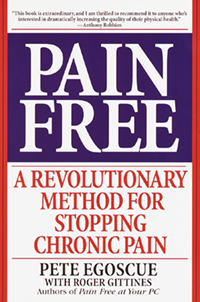
Pete, it’s great to have you on the show.
I’m more than happy to be here. It’s an honor to talk to you, Stephan. What’s on your mind today, brother?
I would love to start with what exactly is the Egoscue Method. Why does somebody need to employ it in their lives?
The method is nothing more than an individualized posture corrective interventions individually provided to clients who come to see us and who are suffering from chronic pain. It’s a referral company. It’s been that way for 40 years. People come to see us from all over the world with something hurting, muscular, skeletal, neurological challenges of some kind. We apply posture, the idea being that when you are what we call designed capable, meaning posturally balanced, that defined as the weight evenly distributed on two feet because we are symmetrical bio pads. When you are that way then you are what’s called low joints. Your shoulders, and your hips, and your knees, and your ankles, you are posturally aligned. You have a range of motion capability. What that means is that the symptoms of chronic pain are histories that they rapidly dissipate.
If you’re misaligned, which most people are, you can go into an Egoscue Center, get diagnosed, see that you have for example one hip higher than the other, or one shoulder higher than the other, or maybe foot more forward than the other and they’ll show you this with pictures. Then, address that with a menu of exercises that will fix you right up.
We do as many Skype appointments as we do in person. We have a worldwide client base. There are a lot of places that we don’t have brick and mortar clinics, but yes Stephan, your explanation is correct. The body wants to be balanced or born. We all have the same design. It isn’t a deviation of design varying birth defect. It wants to be there, so given the right stimulus, the trick is to treat the body as a unit and not try to treat the symptom.
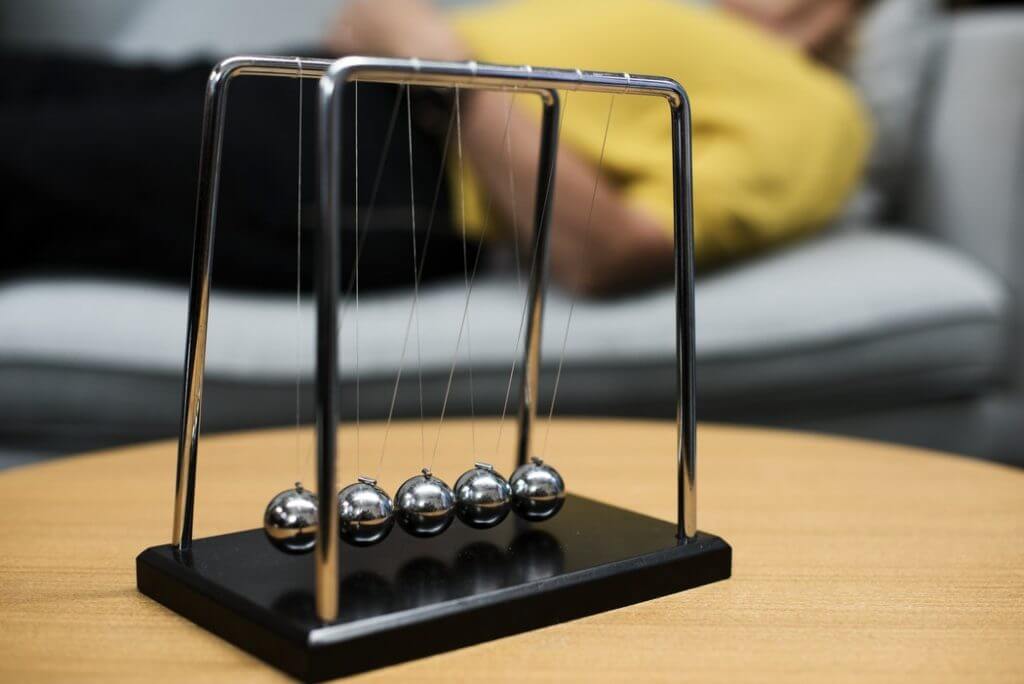
How did you end up coming up with all of these different exercises that make up the menu? Because it’s very individualized depending on how you’re aligned or misaligned. That you might have a certain exercise because one shoulder is higher than the other but then once that’s corrected and something else shows up, you get a totally different exercise. One of the hardest ones I recall was the air bench and that just seems to show up on every menu. No matter what I did, I kept earning that thing. Essentially, you just put your back against the wall and you pretend like you’re setting on a bench even there’s nothing there. It really gets your legs shaking after a little while.
Stephan, I know you feel it in your quads and your thigh muscles, but it really has nothing to do with your quads, it really has to do with, believe it or not, your posterior erector muscles and so as your hip flexors. The origin of it was just myself having my own physical challenges when I was an officer in the Marine Corps and started experimenting around to overcome my own physical limitations. And then, marines, they started to come to me, asking me about their knees, shoulders, hips, elbows, etc. It became a hobby and I just started to experiment with different things even though having been a client, you know that there’s nothing new under the sun. A lot of the things that we do are what you call yoga postures. It’s not the individual exercises, the sequence of things, and I guess that’s the science behind figuring out how to stimulate the body in a way that it brings it in an efficacious manner back to its balance point.
There are other methodologies to get into balance and develop better posture, like Alexander Technique for example. What is it about Egoscue Method that provides something like the Alexander Technique would not?
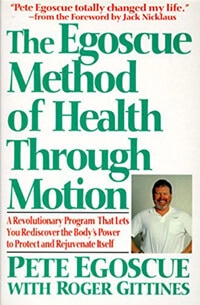
With the philosophy that we’re all in this together, and Alexander, the technique’s been around for a long time, so I can’t speak other than the philosophy of Alexander as you’ve already stated, it’s designed to bring the body back to balance. The difference with us is A, it’s individualized, B, it treats the body as a unit. It’s not formulaic, meaning that it’s an individualized process that changes and adapts as the body adapts. As far as I know, that’s what separates us from all these other techniques. Pilates, Alexander, and all the rest of them.
Did you have a particular injury that made you want to develop this method?
Well, kind of inadvertently. I zigged when I should have zagged. That’s what officers in 1968, 1969 did. I was a platoon commander, I got wounded. That healed up and everything. It was only after I came back to the United States, after being [00:06:43]and all of that stuff, that I started having difficulties. It was inadvertently derived from the method from my physical difficulties that the good folks that were trying to help me kept looking for the damage that had long since healed. That’s what actually drove me to there must be something missing here, because all bones were in place and everything’s healed up. I don’t have all my hamstring attachments and all that, but that shouldn’t account for all this nerve pain that I was having. I just started experimenting around, bought an anatomy book, and started looking. To me, the answer was in the first chapter where it talked about the design function of the human body as a species. I just took a look in the mirror and said “Whoa, you’re not what this anatomy book says.” I just used trial and error and pretty soon I started feeling better.
The nerve pain went away completely?
Yes, how old am I? 70 something and I do all the things that I’ve always done, what we call patch workouts and obstacle course training, and I run, and I don’t have any physical limitations.
Wow, that’s amazing. Do you still speak on stages? You did a lot of speaking, right?
Most of the public speaking now is done by one of my corporate officers. His name is Bryan Bradley, he’s really good at it, audiences love him. You may have seen him at Robbins. You’ve mentioned going to see Tony Robbins.
Yeah, that’s how I was exposed to Egoscue Method was through a platinum partner trip. I’m so glad that that happened because it opened up a whole new world for me. I was completely unfamiliar with even addressing posture with any kind of technique. I hadn’t even heard of the Alexander Technique at that point so what a blessing to have this methodology that I could apply. I saw multiple practitioners like David Smith out of San Francisco. He’s great. I saw him in San Francisco when I was in town there on multiple occasions when I would go to other platinum partner trips and your team would be there to work on us plats and on Tony. Tony’s a huge fan of the Egoscue Method. I’m curious how did all that come about, your connection with Tony, and his familiarity with your method?
30 some years ago, I had one Clinic. It was in San Diego, where the corporate headquarters still resides. We’re not in that same location anymore. We’ve moved several times from that original location, but it wasn’t too far away from some polo fields. Being just one clinic and multiple therapists, we were open six days a week. It was a Saturday morning and five guys struggling came carrying Tony Robbins through the door. He’d been thrown off his polo pony and he was in a tremendous amount of pain, physical pain, musculoskeletal pain, nerve pain, his back was killing him. The only reason that they brought him to see me was the geographical proximity while they were waiting for an ambulance for some reason, was delayed and so one of the people at the polo field knew about us. They brought him in and it happens quickly and he felt much better and we became friends and we’ve been friends ever since.
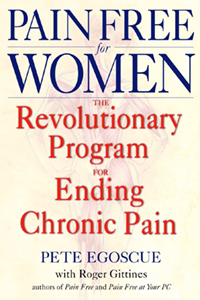
That’s amazing. He incorporated that into his life and to the lives of a lot of his fans and followers by talking about it on stage and bringing your practitioners to some of his events and allowing people to work with those practitioners. That’s been going on for many, many years.
Yeah. He came to me one day. When you know Tony, his mind is incredibly active. He’s very nimble and he’s always looking for the way to make something better. He came to see me and he said, “I got this idea. I want to call it Life Mastery.” I said, “Okay.” He’s going to want you to participate. I said, “Okay.” For a number of years, he conducted a Life Mastery Program in Hawaii and I, myself and five or six therapists would travel to Hawaii every year for a two week Life Mastery Program. That course, Life Mastery now is more and it’s a different now, but back in those days, it was Tony, me, and some other folks. It was a lot of fun.
That is an amazing program. I didn’t do it when it was in Hawaii and it was two weeks long. I did it just a few years ago. They do it Fiji now which is another beautiful location.
Yeah, I’ve been there.
Lauren Slocum runs it now. She does an amazing job. I don’t know if you know Lauren.
I do.
Yup, she’s been on the podcast. Actually, she’s been on my other podcast, Marketing Speak. I am going to have her on this podcast some time later this year on Get Yourself Optimized.
Busy guy.
I am. I’ve got two podcasts. I do a lot of speaking all around the world. I’ve got three books. I got two I’m working on I hope to get published in the next year and consulting clients. Yeah, I’m a pretty busy guy.
What’s your latest book?
Well, it’s actually on personal transformation. Big departure from the internet marketing world, which is what I normally write about, like SEO, search engine optimization, and all that. Now, I’m writing about personal transformation in my journey. I’ll start it with Tony and going to his Unleash the Power Within and doing the firewalk and realizing that, “Hey, I can break through my fear and change everything.” I did. I rebooted my whole life. I’m literally unrecognizable from the guy I was pre Tony. I probably look 20 years older than I was at the time and that was a decade ago. Now, I look 10 years younger and it’s pretty crazy when you see the before and after photos on the website, on getyourselfoptimized.com.
That’s impressive. One of the big challenges that all of us have is it relates to the subject of personal transformation. If you talk about pain which is my will house, the idea of pain, and if you want me to I can elaborate how this happened, in the western medical model, pain means something is wrong. That has appeared in the public and all of us believe it. When we’re hurt, we think there’s something wrong and we’re looking for a solution.
What we do is now we have all of these wonderful diagnostic tools. We’ve MRI’s, CAT Scans, PET Scans. We can actually break DNA, the Helix DNA, and all these wonderful things. Because we can look at that Micro level, we do that. To give you an example, someone shows up at their physician with the back pain. Initially, it’s, “Well, let’s take a look.” On the surface that’s very logical. Let’s take a look. Let see what’s going on, and so we do. We MRI and we look and we’re looking for damage of some kind. We’re looking for everything from a herniated disc, one of these stopped what we call spondy conditions or stenosis, we’re looking for those things. If we find them, we offer to the patient, “This is what the problem is.” Depending on the discipline and the training and the background and experience of the healthcare professional, the protocols are determined from that point. What is dropped out of all of that process is the why. Because, especially in the Orthopedic world, they’re dedicated professionals, they know their crafts, but it has evolved so that when we find something, we now believe in that arena that the what and the why are the same thing.
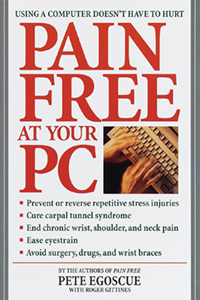
Meaning that what difference does it make why the disk is herniated, the disk is herniated, and therefore that’s what we need to treat. Unless you get hit by a truck, that’s a mistake because if you don’t treat the cause of the problem as you know, you’re doomed to repeat that problem. What we do is we ask a different set of questions. We say, “Okay, what’s wrong with me?” It’s a sick question. We ask our clients, “Do you think you’re sick?” “Sir, no. I’m not sick. I just can’t stand up.” Rather than ask a sick question which is what’s wrong with me, let’s ask a different question. Let’s ask, what is my body trying to tell me? To do that, you’ve got to understand how the body works. It works as a unit. In order to solve that and answer that question, you’ve got to back up, and you’ve got to come away from the micro and you’ve got to go to the macro. You’ve got to look at the body as a unit. How it carries itself, how it moves in its walking pattern, the gate pattern. When you do that, the answers jump right out because the body’s talking to us. That’s what we believe pain is. It’s just the body’s voice. When you recognize it and the body acknowledges that you recognize it, it gets pain free very quickly.
Yup, that’s it, such a paradigm shift. I get caught up in the old model, I have to admit. I have a pain in my left index finger that’s chronic and it’s super sensitive. I’m guessing it’s some sort of neuralgia.
Is it there now?
Yeah, it doesn’t bother me until I bump into it. If I lightly tap on it, it feels like someone took a hammer to it.
Okay, so, right this second, if you tap on it, you’re getting pounded by a hammer?
Yeah. I’ve had an MRI scan of it. They didn’t find anything.
Of course not. You’re sitting at your desk, right?
Yeah.
Okay, let’s impact the symptom. Do you want to do that?
Okay, impact, like let’s make it hurt some more?
No, I wouldn’t do that to you.
Okay, good.
Alright, I want you to get your feet hip-width apart and slightly pigeon-toed on the floor.
Slightly pigeon-toed.
Hip-width apart.
Hip width apart, okay, but I’m still sitting?
Yup.
Okay.
Now, I want you to take your belly button, using your hips. I want you to tip your belly button down towards the floor, which if you use your hips, will produce somewhat of an arch in your lower back. I want tension in your lower back.
Okay.
Relax your stomach.
Okay, how did you know it was tight?
This is not my first.
I know.
Notice that one of your feet, that big toe, wanted to come up off the floor, as you did that. You got to have both your big toes down into the floor as you relax your stomach and put this arch in your lower back.
Okay.
Now hold that arch. This is step two. We’ve got four steps to go here.
Okay.
Just having done that, tap on your finger.
Okay. Yeah, it’s less sensitive.
Of course, it is. It’s as easy.
You’re doing voodoo here. I don’t what you’re doing.
Well, I’ll explain it to you in a minute.
Okay.
Now, keeping your feet flat, slightly pigeon-toed, cranking your hips down towards the floor, what’s called hip extension. The lower back tension will gradually increase as you do this. Now, what I want you to do, without moving your arms, I want you to, you know your shoulder blades, your scapula?
Keeping your feet flat, slightly pigeon-toed, cranking your hips down towards the floor, what’s called hip extension. Share on XYeah.
I want you to squeeze them together. Not up. Don’t shrug your shoulders up. Pin your shoulders blades to your spine and then let them go 10 times. You will feel that your left one doesn’t glide like the right one. They’re different. One of them stuck. Can you tell that?
I think it’s my left one.
Really? You think?
Yeah. I mean it feels tighter.
It’s stuck. Now, don’t lose that curve in your lower back.
Okay. Yes, I was. I was losing it.
Keep your stomach out of this.
Okay.
Alright. Now, tell me when it starts to glide, that left shoulder, that scapula.
What do you mean glide?
Free up.
Okay, so I’m just keeping doing this just kinda.
Yeah, you’re loosening up.
Loosening up, okay.
Hit that curve in your lower back.
Okay.
You’ll feel your left shoulder blade, the feeling up there, catch up with what the right one’s doing.
Okay.
Do you feel that?
Yeah, it feels not as tight.
Good. Now pin them together and hold it, your shoulder blades. Not up. Your shoulders are down and back.
Yup.
Got an arch on your lower back. Yes?
Yup.
Now, tap on your finger.
Okay, it’s still sensitive and painful, but it’s not as severe.
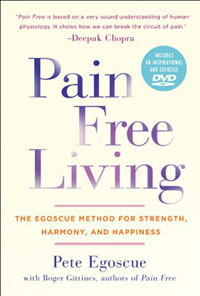
Okay, what did we just do here? The issue is not in your finger. It’s not in your carpal tunnel. It’s not in your wrist, even though you’ve got a little carpal tunnel impingement. It’s coming from the position of your shoulder. You’ve got nerves that originate up in your cervical spine and they come down out of the spine and they cross through the shoulder, and they come down into the arm, and that finger is just telling you that you’ve got some nerve impingement going on but the origin of it is coming from your shoulder. We know that because your shoulder blade, I know the position of your shoulder is compromised because that shoulder blade should glide easily, like the right one does. You want to fix this, you want this to go away, we’ve got to change the position of that shoulder which is really easy to do.
Okay, that’s good.
That’s why they couldn’t find anything in your finger and in your hand and stuff because there’s nothing there to find. You’re not broken. You’re not sick.
Yeah.
Fair enough?
Yeah, I’m sold. I really want to get rid of this thing.
It’ll happen really quick.
Okay, alright. I know you got an Egoscue location locally here in Sta. Monica. It’s time for me to go in, it’s been too long. I’ve been meaning to get back into Egoscue.
It’s fun.
How many of these different exercises are there? There must be many dozens of them, right?
Do you mean in my database?
Yeah.
Currently, there are over 400.
400?
Yes.
Wow!
The new machine learning, and I won’t worry with laborious process to get this done, but my new EP, it knows every muscle in the human body. It knows its proximal distal, its origin, and insertion attachments. It knows every nerve in the body, every bone in the body. It knows the action and the reciprocal action of muscles on all of those joints. Because of that, we’ve been able to positively pair down the number of exercises that can be selected to about 100.
I’m actually holding my daily menu. It’s got a bunch of exercises for me to do that I would be really bad about doing. I missed them a lot and go days at a time without doing it, but it includes things like static back, assisted hip lifts, standing windmill, standing arm circles, counter stretch against the wall, sitting knee pillow squeezes, that was always fun. Let’s go through a few of these so people can get a sense for what the Egoscue Method is about, how you have these tailored exercises, and there’s, as you said, 400 in sum to choose from that the practitioner will pick for your based on what your issues are.
Yeah, and of course with machine learning upon this now, the image capture will now offer to the practitioners some exercise selections. It absolves the practitioner from having to use their experience as it relates to menu creation because the hard data of the machine learning is going to take care of that. But you’re right, that’s the process. You appear, we evaluate the posture, based upon the posture there is a stimulus, we call them menus, as you said, you implement the Menus in the sequence provided and away we go.
You can do that anywhere. You’re going to have a daily menu that is for where you are normally and you can have different things available to you, like pillows.
Yeah, you don’t need equipment.
Yeah, but then I also have a travel menu, which is for when I don’t have anything with me and I can still, as long as I have a wall I can push against and something to sit on and so forth, I can still go through these exercises, but it’s a shorter menu because if I’m traveling I’m usually tighter on time and so forth. You can have both the regular daily menu and the travel menu.
Do me a favor. You can have a Skype appointment too, if you wish. Let say you go over there in Sta. Monica, to the clinic, do yourself a huge favor. When you walk in there, be honest about the amount of time you’re willing to devote everyday.
Okay.
Don’t let us tell you this is what you need to do. You tell us the amount of time that you have because time is a premium. And then our task is to fill up that amount of time with the appropriate menu for you to do which will encourage you and we all have this time rush. We all have time pressure. But if you remove the, “Oh, I got to find an hour,” or whatever. If we can remove that from your daily life, you will be much more inclined to keep yourself functional.
Yeah, because even doing just 10 minutes a day on a regular basis is so much better than doing the full 45 minutes but only doing it once every few weeks.
When you go in there, say, “Look, I’ve got x amount of time.” They will smile at you and say, “Fine.” If they don’t, you call me.
The human organism is two things. It’s a generator of energy and it’s an attractor of it.
Okay. I sit a lot at my computer. I’m guessing that a lot of our listeners do that as well. Many of us have computer jobs. Sitting is like the new smoking. I don’t want to die young. What’s the antidote? Is it just simply doing Egoscue for 10 minutes a day and that’s going to keep you alive and healthy for a very long time, or do you suggest people get standing desks? Do they need to give more time with Egoscue?
No. I’m going to take you on a little journey here to answer your question.
Okay, let’s do it.
Bear with me. The human organism is two things. It’s a generator of energy and it’s an attractor of it. Not to really complicate this discussion, but cells absorb nutrients and they give up waste. The waste is always in the form of acid. We know the most common acid is muscle acid, we call it lactic acid.
Yup.
It is an acid exchange whether it’s an organ or a nerve, or a bone cell or a brain cell. The process is on a molecule of fluid, a molecule of oxygen, and a molecule of blood sugar, glucose. The cell absorbs it. It extracts the glucose. It extracts the oxygen. It affixes the waste and expels the wastes. The faster that exchange happens, the healthier the cells. The generator of that energy, to do that, is the muscular-skeletal system. That’s what it’s for. It’s to generate this, what you and I will call the metabolic rate. The higher the metabolic rate, the healthier the organism. You with me so far?
Yup.
In effect, we’re a movement machine. It isn’t that we’re not designed to sit. If we couldn’t sit, we wouldn’t be able to sit. That’s not the problem. When I wrote one of my books called Pain Free At Your Personal Computer, the ergonomics industry went berserk because when I wrote the book, ergonomics, well-intended folks redesigning desks, redesigning workplaces, corporations fit, millions of dollars with ergonomic experts trying to figure out where all this chronic pain was coming from. The experts were right that prolonged sitting is not good, but where they missed it, it wasn’t the workplace. It was the body that’s coming to the workplace. You don’t need a new desk, you don’t need a new chair unless you don’t like your chair. What you need to do is you need to come to that sitting position with your metabolic rate intact with your body balance. It’s easy to do. You don’t have to worry that the prolonged sitting is not good for you, as long as, you’re in, you know that posture I put you in to impact your finger?
Yup.
That posture. If you’re in that posture your metabolism is roaring. Another interesting thing happens, Stephan, when you do that. It occurs to you to get up every once in a while. It will occur to you. Your body will tell you, “Okay, get up. Go get some water. Go do whatever.” The other formula that your listeners, and I know they get told this constantly by nutritionists. You gotta stay hydrated. Those screens are a dehydrant. They dehydrate tissue. Just the electronics, the proximity to the electronic devices that we all use are tissue dehydrators. Research is pretty clear about that. Everybody says, “You gotta drink more water.” We get well-intended, we get a big bottle of water, you put it on your desk and at the end of the day, it’s still sitting there. The reason for that is because chronically dehydrated people have lost their thirst response. You don’t get thirsty. The body is incredibly intelligent. You would think, “Wait a minute. If I’m chronically dehydrated, my body should be screaming for fluid.” Well, it is, but it’s not your thirst screaming. It’s your chronic pain, it’s your swollen ankles, it’s your varying eyesight, it’s your interrupted sleep, it’s your intermittent bowel process, it’s all of those things showing up. Here’s how to overcome chronic dehydration, you’ve got to drink until you’re thirsty. Once you start doing that, then your thirst response comes back. When you’re thirsty, your body will say, “Hey, my mouth is dry. Hit me with some water.” Here’s the way to do it. Do you know those little Dixie cups, those little tiny Dixie cups?
Yeah.
You get one. Everybody can do a shot. Everybody can just throw back a Dixie cup full of water, so you get a Dixie cup and you throw back two or three, four? You do that a couple of times a day and pretty soon your thirst response comes back and then that bottle of water on your desk could be empty at the end of the day. It works every time.
When you say throw back a shot, a Dixie cup amount of water. That’s one when you’re thinking of getting this habit of doing that multiple times a day? Or you do two or three of those all at once?
Yeah, it’s easy. Pour, boom. Pour, boom. Pour, boom.
Okay.
And then you go, “Okay, fine.” Well then, about two days, your mouth feels like you’re chewing on cotton. Your thirst response is back, and now you’re back and you’re on the road to hydration and that’s a big part of this office sitting equation to avoid suffering from chronic pain.
Some folks will not realize that they’re having symptoms that are based on dehydration and other things that were poor health choices, that they’re not taking care of their body. You mentioned varying eyesight. That’s an interesting one and I don’t even think about that, like if your eyes site is worse on one eye than the other?
No. During the day, your eyes get tired.
Yup, okay.
If the eye muscles aren’t getting the nutrients that they need, they get tired and quit working.
How does the eye focus? Muscles, right? The lens focus is based upon the contraction and the expansion of the eye muscles. If those eye muscles aren’t getting the nutrients that they need, they get tired, they quit working, it’s just like your bicep. It’s just like your thigh muscles or your hamstrings or anything else. If you’re chronically dehydrated, you’re not getting the fuel. At the very least, your optic nerve, your optic nerve requires tremendous amounts of oxygen and fuel, tremendous amounts. You’ve been staring at the computer and you’re working away and you’re working away and your eyes get tired. You go, “Oh, man I’ve been staring at this computer.” That’s a clear sign of dehydration.
Got it. How much water do you drink a day?
Here’s the formula. God, formulas. I hate formulas. Here, I’m giving you formulas. I hate them. I hate rules. Rules are an excuse to not be present. But anyway, here’s the formula. Take your body weight, divide it in half and convert that to ounces and that’s the amount of ounces you need every day. If you weigh 180 pounds, half of 180 in ounces every day.
90 ounces a day if you’re 180 pounds. Got it.
Most bottles you can get the 1-liter bottle, right? That depends. Some are 33 ounces and some are 30 ounces or the 12 ounces, but you see how many 12 or 14 ounce bottles you have to get everyday to be hydrated.
Yup. Soda doesn’t count?
For every soda, you got to add three bottles of water.
Oh! Glad I don’t drink soda because it’s a diuretic, right?
For your listeners, sugar is poison. You ingest sugar. The body says, “Goodie, goodie. It’s fuel. We don’t have to do anything. We don’t have to go through a digestive process. All we have to do is absorb.” It says, “Lovely, I don’t have to expend energy to get energy. It dumps it right into the system.” While the body doesn’t want rapid fluctuations of blood sugar, let’s say you eat a Mars bar and drink a regular coke. Let’s say you do that for a little pick me up or you super-size or whatever, the body dumps it into the bloodstream. For the first 10 minutes or so, everything is really cool. It’s dancing and going, “Oh, this is fun, this is fun. We’re so good.” You feel that lift of energy. Then the body says, “Wait a second. There’s too much blood sugar here. Oh, we know what to do.” It secretes insulin. Because it was such a rapid dump of blood sugar, it overreacts. It secretes enough insulin to get rid of that. Then, what happens?
Then, you have that sinking feeling. You ate a donut and had coffee with sugar & cream, by the way, caffeine is good for you, but not the sugar and cream. Anyway, you had it at [8:00]. By [10:30], you’re yawning and you’re looking for another pick me up. What’s happened? Your body took the insulin, had an insulin dump. It gobbled up the blood sugar. Now, down those blood sugar. If you don’t do something, the body has another system, it’s called adrenaline. It says, “Hmm, our metabolism is dropping here rapidly,” and it hits you with adrenaline. All day long you’re going through this bell-shaped up and down up and down up and down. It is exhausting. The good folks said in the soda business, and the sports drink business, they know that so they created diet soda. Here’s another rule for your listeners.
Sugar is poison.
When you look at the ingredients, if you can’t pronounce them, neither can your body. You don’t want to ingest them. You ingest all of those chemicals that you can’t pronounce and you have no idea what they are. The body says, “What in the hell is this stuff?” In its wisdom, the perfect system, it kicks it to the liver. Say, “Hey, liver. You deal with this.” Well, livers are already under hard work, so down we go, and that’s the issue. You know the origin of Gatorade?
No.
The reason it’s called Gatorade, it’s because it was originally developed at the University Of Florida, the Gators. It was an electrolyte replenishment. It was basically colorless and tasteless, and it worked like a champ. Athletes profited by it. Then, Corporate America discovered it and said, “We want to sell lots of this stuff.” Now, what is Gatorade? Sugar water.
Yeah, that’s for sure.
Sugar water. One of the things that we do with our athletes, as you know we got professional athletes in every sport in all levels, men, women and so forth, we give them off of the sports drinks. We get them back on water and their performance levels go up.
Awesome. Sugar is poison and I wholeheartedly agree. I’ve recently in the last year and a half gotten off of sugar. I don’t eat dessert anymore except on special occasions like my birthday or Christmas. I don’t have desserts. I very rarely will have sugar. I might have a bit, Ketchup has a fair amount of sugar. I’m careful I don’t have a lot of…
Yeah, you can get organic ketchup, doesn’t have sugar in it.
Okay. I have organic ketchup. Annie’s brand ketchup is what I eat, but there’s still sugar in it.
Yeah, you can get organic sugar. That’s another thing. Corporate America, the food industry is brilliant. They’ve hijacked the word organic. When you think about it, everything’s organic.
Yeah, until it’s been poisoned.
Exactly, you can use the word organic. They figure out how to do that, and I’m not criticizing. That is just brilliant what they’ve done to our food sources, it’s incredible.
What do you do? Do you go to the local farmers market?
I will confess that I’m extremely blessed. I have had for a very long time cook chefs. My chefs go to the organic markets every day just like folks do in other parts of the world and they shop for fresh produce and organic proteins and so forth, and they bring it back and prepare it. That’s what I do.
Very cool. I’m guessing not many of our listeners have their own private chef so for the rest us, what do you recommend?
If you want to honor yourself nutritionally, you’re going to have to pay attention to it.
Really simple. I get the convenience requirements, I’m not downplaying the significance of convenience and cost, I’m just not. I would like to have a simple one rule fits all for the convenience and cost. The truth is that if you want to honor yourself nutritionally, you’re going to have to pay attention to it. You can’t unconsciously eat. There’s just no way around it. You’re going to have to avoid the fast-food industry for one. The fast-food industry has been to visit me. They’ve graciously asked me to come and visit their food prep places. They’re puzzled as to why, because they really, really make an effort. Believe it or not folks, they go to tremendous lengths to provide quality, not all fast foods, but the big ones, the ones that have been around a long time, The Wendy’s, McDonald’s and so forth, they go to tremendous lengths to provide high-quality food products, they really do. They don’t understand why all the research shows that this consumption of their product is so detrimental to the human body. Here’s why.
You can take the same ingredients that McDonald’s has that they’re proud of and they should be because they go to tremendous lengths to get this stuff. With great care, preserve it and present it. Here is the rub. It’s not what you do, it’s why you do it. It’s not what you think, it’s what you believe. The preparation of a fast-food hamburger, the intention is to provide the product for consumption and the motive of exchange is money. The same ingredients prepared by someone at home, the intention is nourishment. That intention changes, the research is out there, your listeners can go look it up. If they look around, all of these research studies are available. The intention then changes actual processing that the human digestive system, absorption system goes through to assimilate the ingredients of the food. What’s the answer? The answer is you gotta pay attention to what you put in your mouth. If your intention is nourishment and not convenience and not speed and not cost, you’re healthy.
What about vegetarianism? What about the Mediterranean diet? Here’s the deal. Over on one side, you’ve got the vegetarian folks. They have mountains and mountains of research that proves that they are beneficial to the human body. They have legions, legions of devotees that can prove it and verify it and speak to it. On the other side, you’ve got the Barry Sears of the world, Dr. Sears, and he’s the protein guy. He’s the high fat, high protein guy. He’s got volumes and volumes of research that proves that he’s right and legions of devotees who speaks to the efficacy of his approach. Who’s right? The answer, they’re both right. The human body will burn almost anything unless you can’t pronounce it. It’s not what you eat, it’s what you believe about what you eat. Well, come on Egoscue how can say that? 40 years of helping people lead more active, higher energy, better focus, more enthusiastic, joyful lives. To me it’s an era of observation.
I love that. I recently started this habit of blessing my food before I eat it.
Perfect!
Another thing that inspired that change over the last year is I’m taking Kabbalah classes and that’s part of it but also the research I learned about from Dr. Emoto, on the water crystals?
That’s cool. His book is fascinating. I’ve met him.
Unfortunately, he’s passed away.
Yeah, I met him in Japan.
What an amazing guy and amazing research. I was really impacted by that. I still believe it and that just goes along with what you’re saying about what you believe about your food and the intention that you put on it as you’re preparing it or whoever is preparing it for you, matters. It changes the structure of it.
Life is better than the old days before this stress of the pace of modern living.
It absolutely does. One of the great things about the modern age of internet access with all of the, I’m not one of these guys who say, “Life is better than the old days before this stress of the pace of modern living.” These are the best times to live. One of the huge advantages that we have is that awareness of the subject is becoming more and more widespread which I view with great joy.
Awesome. I have another question here so let’s move from the nutrition side to the exercise side of things. How long do you exercise per day? How many days a week? Are you just doing the Egoscue Method? Or you’re doing other things, and what are those other things?
My menu is pretty consistent. I change it up. It takes me about 30 minutes every day. I never miss it. I work out, that’s 30 minutes and then I spend at least another hour, most days another hour and a half, so my self-care, my structural self-care, 7 days a week, the average is 2 hours a day.
Awesome. I love how you put that, structural self-care. Most people talk about just exercise. “Oh, I got to exercise. I got to work out.” But structural self-care and that’s how you’re going to be able to run marathons when you’re in your 90’s.
That’s correct. Remember the body doesn’t know how old it is. It can’t measure birthdays. What it knows, because it’s a living organism, it knows stimulus. What it does is what all living organisms do, it takes the stimulus that it’s preserved with, and that’s not just physical but it’s emotional, psychological, nutritional, spiritual. It doesn’t judge it. I know, we experts, we’re all full of crap. We’re all telling you how to live your lives and we’re all wrong. You know more about yourself your health than anybody on the planet. Unfortunately, at least the American public and you know we have clinics all over the world but, primarily the Americans don’t believe that. We’ve convinced ourselves that some healthcare expert like Pete Egoscue knows more about me than me, and that’s just not true. This idea that someone knows more about you than you isn’t true. The trick is to get in touch and from you telling me your story of your experiences with Robbins, you now know that, Stephan.
Right.
That’s the key. What the body does is it takes the stimulus presented to it, and it says, “Okay, how do I react? How do I compensate? How do I adapt?” The reason we’re still at the top of the food chain. Think about this, 98% of all the species that were on this planet, when the human got upright, are extinct. We’re still here. Why? Because we’re so adaptable. Our organism is a marvelous machine. Folks, we are not fragile, we are not. We are really, really, really tough. This modern environment is designed to deal with it, but you gotta pay attention. If you’ll pay attention, you’re really in good shape. Do you ever go to the gym?

Yup, I go to the original Gold’s Gym in Venice Beach..
Okay, you noticed that there’s a lot of effort going on in that gym?
Yeah.
And not a lot of joy in there. We’ve convinced ourselves that effort produces results and fitness means effort and judgment. If you could do 10, you should be able to do 15. If you can run a 10-minute mile, you should be able to run an 8-minute mile and on and on and on. We’re constantly self-judging. We’re constantly striving for six-pack abs or whatever it is. The jure of the moment in the fitness world and the cycles change rather quickly. Fitness is nothing more than peace of mind. Health and fitness are the same thing. When you enjoy peace of mind, you are healthy.
Yup, I love that. Your definition for fitness, peace of mind.
Peace of mind, joyful, it’s got to be fun, movement, and all these studies show this. They don’t know what they’re really looking at but they observe, “Wow, we’re getting this much benefit out of a 30-minute walk as we are on a 5-mile run. How is that possible?” Things like that. This has been a lot of fun, Stephan. I’d like to do it again sometime.
Yeah, for sure. Thank you so much. If somebody wanted to learn more about the Egoscue method maybe, do a Skype session with one of your practitioners.
egoscue.com.
Awesome. Thank you, Pete. Thank you, listeners. This is Stephan Spencer, your host, signing off. We’ll catch you on the next episode of Get Yourself Optimized.
Important Links
- Pete Egoscue
- Egoscue University
- Egoscue clinic locations
- Facebook – Pete Egoscue
- Twitter – Pete Egoscue
- Pain Free
- The Egoscue Method of Health Through Motion
- Pain Free for Women
- Pain Free At Your PC
- Pain Free Living
- Loren Slocum Lahav – MS previous episode

